
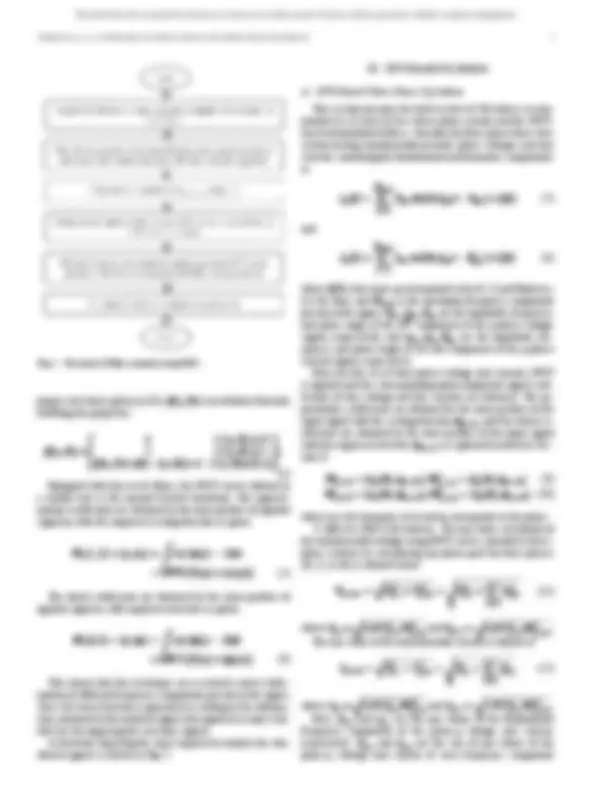
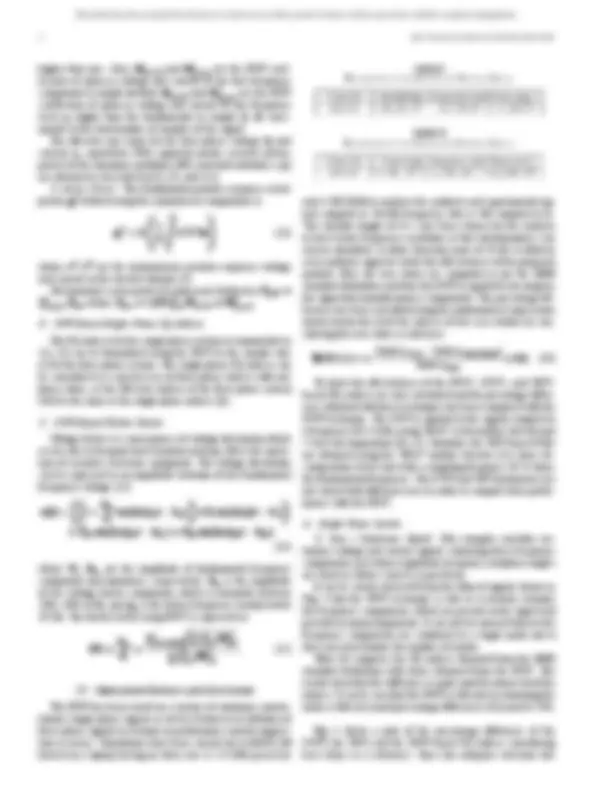
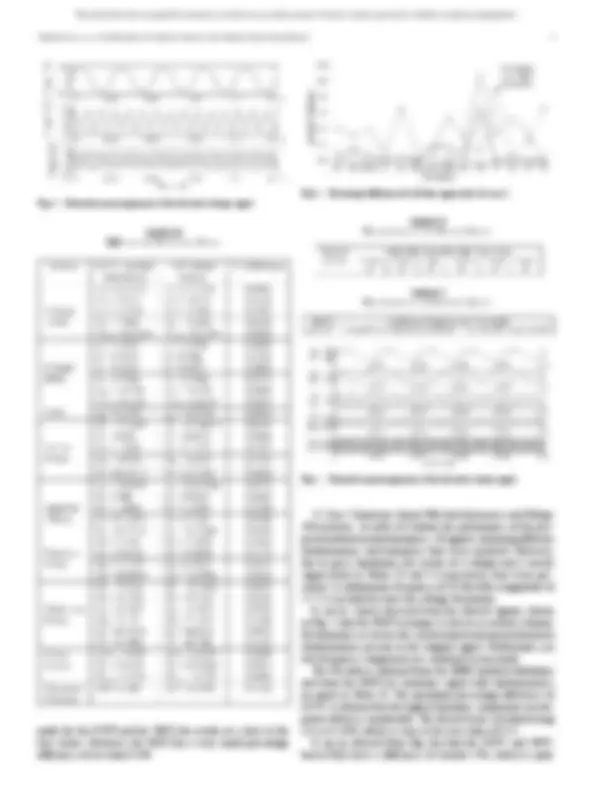
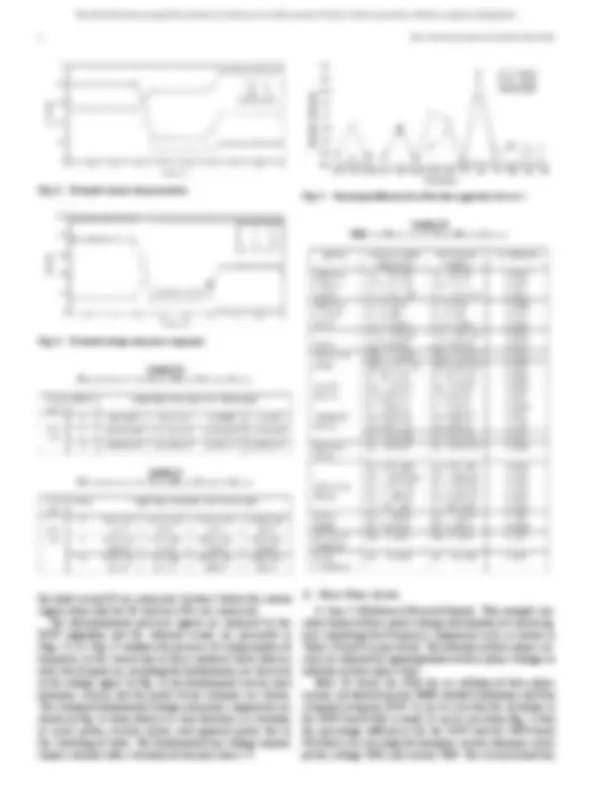
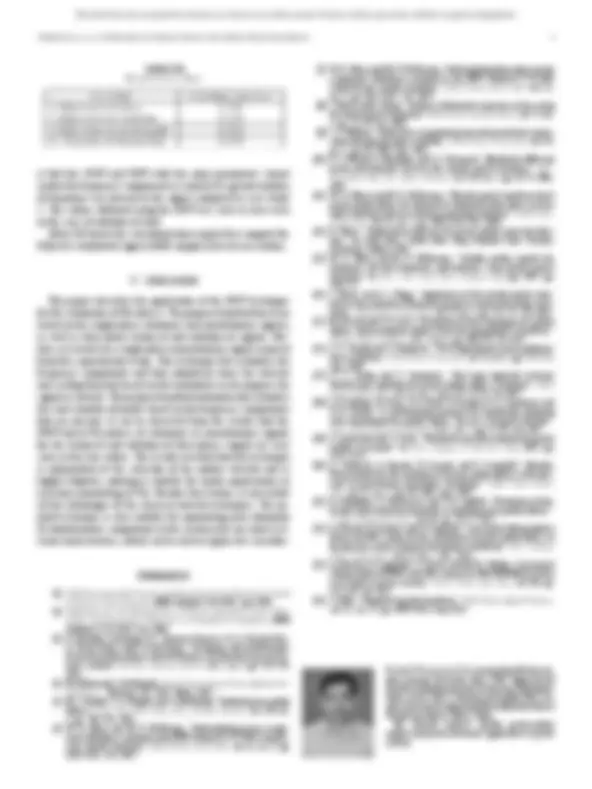



Study with the several resources on Docsity

Earn points by helping other students or get them with a premium plan


Prepare for your exams
Study with the several resources on Docsity

Earn points to download
Earn points by helping other students or get them with a premium plan
Community
Ask the community for help and clear up your study doubts
Discover the best universities in your country according to Docsity users
Free resources
Download our free guides on studying techniques, anxiety management strategies, and thesis advice from Docsity tutors
power quality indices using EWT
Typology: Thesis
1 / 10

This page cannot be seen from the preview
Don't miss anything!







IEEE TRANSACTIONS ON POWER DELIVERY 1
Abstract— Application of an empirical wavelet transform (EWT)-based time-frequency technique is proposed in this paper for the estimation of power-quality indices (PQIs). This technique first estimates the frequency components present in the distorted signal, computes the boundaries, and then filtering is done based on the boundaries computed. This technique is effective and offers many advantages over other techniques because the scaling func- tion and wavelets adapt themselves according to the information contained in the signal and no prior information regarding the signal is required. Besides this, the advantages of the discrete wavelet transform (DWT), wavelet packet transform (WPT), short-time Fourier transform (STFT), windowing techniques, and filter bank techniques also hold. Simulated and experimental test signals with power-quality disturbances have been analyzed and the effectiveness of this technique has been shown by comparing the PQIs estimated by using the proposed method with those obtained using the DWT and WPT. The results confirm that the EWT efficiently extracts the mono component signals from the actual distorted signal and thereby accurately estimates the PQIs.
Index Terms— Empirical wavelet transform (EWT), IEEE Stan- dard 1459–2000, power-quality indices (PQIs).
ITH THE growing importance of maintaining power quality (PQ), it has become essential to quickly quantify the PQ disturbances and analyze them. The PQ disturbances can be categorized into stationary and nonstationary signals. The stationary signal is the one in which mean and variance do not vary with time while in the case of a nonstationary signal, either of them or both may vary with time. Since most PQ disturbances are noisy and nonstationary in nature, an advanced signal-pro- cessing technique is required to accurately decompose the non- stationary power signal and determine the location of frequency components in time as well. The traditional power-quality in- dices (PQIs) recommended in the IEEE standard 1459–2000 [1], [2] are based on fast Fourier transform (FFT), which poses lim- itations in the analysis of a highly nonstationary signal. While analyzing the nonstationary signal, the FFT spectrum will result in spectral leakage, that is, the presence of several insignificant frequency components in the spectrum. The other limitation of
Manuscript received March 20, 2014; revised July 22, 2014; accepted August 28, 2014. Paper no. TPWRD-00312-2014. The authors are with the Department of Electrical Engineering, In- dian Institute of Technology Indore (IITI), Indore 453441, India (e-mail: phd1301102004@iiti.ac.in). Digital Object Identifier 10.1109/TPWRD.2014.
FFT is that it does not give time information, that is, where those spectral components appear in time. Reference [3] presents an interesting review of mostly used signal-processing techniques for the estimation of PQ indices and algorithms for classifying power disturbances. The dis- crete Wavelet transform (DWT) has been frequently used for evaluating the quality of nonstationary power signals [4], [5]. The DWT provides nonuniform frequency bands; moreover, if suitable sampling frequency and decomposition levels are not chosen, then two or more frequency components will be present in the single subband. In [6], the reformulated PQIs have been presented using DWT and also extended the work to the three-phase system [7]. Wavelet packet transform (WPT) is an extension of the wavelet transform, which is effective in analyzing the nonstationary signal and can accurately measure the electrical quantities [8]–[10]. Even though the WPT has shown interesting results in estimating PQIs [11], the frequency subdivision scheme is based on a constant prescribed ratio, limiting its adaptability. The suitable selection of sampling frequency and adequate choice of the mother wavelet [12] can minimize the leakage errors between wavelet levels [13], [14]. Once a mother wavelet function is chosen, the same function should be used to analyze the entire data. However, a single mother wavelet that is chosen cannot analyze the real-time signal having different frequency components varying with time. This requires preprocessing of the signal characteristics, which is generally impossible in real-time measurements. The literature survey reveals that the analysis of a signal with the discrete wavelet transform (DWT) or the wavelet packet transform (WPT) requires a proper selection of mother wavelet, decomposition levels, and sampling frequency. The selection of these parameters, along with a suitable choice of a mother wavelet, differs for the signals containing different frequency components and this limits the application of WT and WPT to analyze real-time nonstationary signals. To over- come these drawbacks, various adaptive techniques have been proposed, such as the S-transform and recursive Newton-type algorithm [15]–[18], to assess the PQ indices for stationary and nonstationary signals. In the literature, parametric high-reso- lution methods, such as the Prony, ESPRIT, and root-MUSIC methods [19]–[21] have been proposed to calculate the PQ indices. Recent contributions have extended the concepts to hybrid methods using DFT and parametric methods [22], [23]. Recently, in August 2013 [24], a new approach, empirical wavelet transform (EWT), has been proposed to build a family
0885-8977 © 2014 IEEE. Personal use is permitted, but republication/redistribution requires IEEE permission. See http://www.ieee.org/publications_standards/publications/rights/index.html for more information.
2 IEEE TRANSACTIONS ON POWER DELIVERY
of adaptive wavelets capable of extracting different compo- nents of a signal. This method has an advantage of adaptability according to the analyzed signal and can isolate the different modes of the signal. To the best of the authors’ knowledge, this technique has not been explored until now to analyze the power signal. An attempt has been made in this paper to utilize the self-adaptiveness of the EWT in estimating the PQIs. The performance of this method has been investigated on several systems. It is also well suited to analyze the stationary and highly distorted nonstationary signals. The remainder of this paper is organized as follows: Section II presents a review of EWT technique required to analyze the signal. Then, the EWT-based PQ indices for a single-phase and three-phase system are listed in Section III. In order to investi- gate the effectiveness of this method, EWT-based single-phase and three-phase PQ indices are calculated in Section IV consid- ering a few test signals, including stationary and nonstationary disturbances. Finally, the conclusion is given in Section V.
II. E MPIRICAL W AVELET T RANSFORM This technique was proposed by Jerome Gilles [24] with an objective to extract different modes by building adaptive wavelets. This method works in the following three steps: Step 1) Determine the frequency components of the applied signal using FFT. Step 2) The different modes are extracted by obtaining proper segmentation of the Fourier spectrum. Step 3) Apply Scaling and wavelet functions that correspond to each detected segment. The segmentation of the Fourier spectrum is the most important step that pro- vides the adaptability to this technique according to the analyzed signal In [24], the number of modes ( ) is assumed fixed. Local maxima in the Fourier spectrum were detected first and only the largest M-1 maxima were considered to obtain the M frequen- cies. However, this approach is not suitable for real-time PQ analysis. Therefore, in this paper, the number of modes is esti- mated from the Fourier spectrum by using thresholds for mag- nitude as well as frequency deviation. Consider a real signal x(t), which is sampled at a frequency of
. First, apply the FFT to the discrete signal x(k) to obtain the frequency spectrum and then find the set of maxima in the Fourier spectrum using the magnitude and frequency distance thresholds and deduce their corresponding
Fig. 1. Fourier spectrum with detected boundaries.
frequency. Here, is the number of frequency components estimated using FFT. The magnitude threshold for recognizing the significant frequencies is specified as 3% of the fundamental magnitude whereas the threshold for frequency distance is as- sumed as 8 Hz to avoid the overestimation of fake frequen- cies. Now, with this set of frequencies cor- responding to maxima, the Fourier spectrum is seg- mented into segments, where each segment is defined as [24]. Assuming 0 and , the boundaries (the dotted line in Fig. 1) are obtained as given in (1), representing the center of two consecutive maxima
for (1)
where , are the frequencies, and is their cor- responding boundary. Then, the Fourier segments will be
Fig. 1 illustrates the detection of boundaries from the Fourier spectrum, where the squares that are shown correspond to the maxima, and the dotted lines represent the boundaries found. It can be clearly seen from the figure that the algorithm is able to isolate the different modes. After obtaining the set of bounds , a bank of wavelet filters, comprised of one low-pass filter and M-1 band-pass filters are defined based on the well-detected boundaries. The expressions for the Fourier transform of scaling function and the empirical wavelets are given by [24], as shown in (2) and (3) at the bottom of the page, where where is a parameter to ensure no overlap between the two consecutive transition areas, whose
if otherwise
and if if if otherwise
4 IEEE TRANSACTIONS ON POWER DELIVERY
higher than one. Also, and are the EWT coef- ficients of phase-p voltage and current of the first frequency component at sample while and are the EWT coefficients of phase-p voltage and current of any frequency level , higher than the fundamental at sample. corre- sponds to the total number of samples of the signal. The effective rms value for the three-phase voltage and current , equivalent THD, apparent power, reactive power, power factor, harmonic pollution (HP), and load unbalance ( ) are obtained as described in[2], [7], and [11]. 2) Active Power: The fundamental positive-sequence active power defined using the symmetrical components is
where are the instantaneous positive-sequence voltage and current in the wavelet domain [7]. The harmonic active power of a phase is defined as where.
B. EWT-Based Single-Phase PQ Indices
The PQ indices for the single-phase system recommended in [1], [2] can be formulated using the EWT in the similar way as for the three-phase system. The single-phase PQ indices can be considered as a special case of three-phase indices with one phase alone, so the effective indices of the three-phase system will be the same as the single-phase indices [6].
C. EWT-Based Flicker Factor
Voltage flicker is a consequence of voltage fluctuation which occurs due to frequent load variation and may affect the opera- tion of sensitive electronic equipment. The voltage fluctuation can be expressed as an amplitude variation of the fundamental frequency voltage [15]
where , are the amplitude of fundamental frequency component and harmonics, respectively. is the amplitude of the voltage flicker component, which is normally between 10%–20% of , and is the flicker frequency usually below 20 Hz. The flicker factor using EWT is expressed as
The EWT has been tested on a variety of stationary, nonsta- tionary single-phase signals as well as balanced or unbalanced three-phase signals to evaluate its performance and decomposi- tion accuracy. Simulations have been carried out in MATLAB hosted on a laptop having an Intel core i5 1.8-GHz processor
TABLE I P ARAMETERS OF THE S TATIONARY V OLTAGE S IGNAL
TABLE II P ARAMETERS OF THE S TATIONARY C URRENT S IGNAL
and 4-GB RAM to analyze the synthetic and experimental sig- nals sampled at 10-kHz frequency, that is 200 samples/cycle. The window length of 0.4 s has been chosen for the analysis to have better frequency resolution so that interharmonics can also be identified. A white Gaussian noise of 20 db is added to each synthetic signal to verify the effectiveness of the proposed method. First, the true values are computed as per the IEEE standard definitions and then the EWT is applied to decompose the signal into monofrequency components. The percentage dif- ference has been calculated using the mathematical expressions shown below for all of the indices of five case studies by con- sidering the true value as reference
difference
Indices Indices Indices
To show the effectiveness of the EWT-, DWT-, and WPT- based PQ, indices are also calculated and the percentage differ- ence obtained with these techniques has been compared with the EWT technique. The DWT is applied to the signals sampled at a frequency of 6.4 kHz, using “db10” as the mother wavelet and 5-level decomposition [6], [7]. Similarly, the WPT-based PQIs are obtained using the “db43” mother wavelet [11], three de- composition levels and with a sampling frequency of 32 times the fundamental frequency. The DWT and WPT parameters are not varied with different cases in order to compare their perfor- mance with the EWT.
_A. Single-Phase System
Fig. 4 shows a plot of the percentage difference of the DWT, the WPT, and the EWT-based PQ indices considering true values as a reference. Since the adequate selection was
THIRUMALA et al. : ESTIMATION OF SINGLE-PHASE AND THREE-PHASE PQ INDICES 5
Fig. 3. Extracted monocomponents of the distorted voltage signal.
TABLE III PQI S FOR THE S TATIONARY S IGNAL
made for the DWT and the WPT, the results are closer to the true values. However, the EWT has a very small percentage difference of less than 0.4%.
Fig. 4. Percentage difference for all three approaches for case 1.
TABLE IV P ARAMETERS OF THE V OLTAGE S IGNAL
TABLE V P ARAMETERS OF THE C URRENT S IGNAL
Fig. 5. Extracted monocomponents of the distorted current signal.
2) Case 2 Stationary Signal With Interharmonics and Voltage Fluctuations: In order to evaluate the performance of the pro- posed method on interharmonics, 20 signals containing different interharmonics and harmonics have been analyzed. However, due to space limitations, the results of a voltage and a current signal listed in Tables IV and V respectively, have been pre- sented. A subharmonic frequency of 10 Hz with a magnitude of 7.5 V is included to have the voltage fluctuation. It can be clearly observed from the filtered signals, shown in Fig. 5, that the EWT technique is able to accurately estimate the harmonics as well as the synchronized and nonsynchronized interharmonics present in the original signal. Furthermore, no two frequency components are combined in any mode. The PQ indices obtained from the IEEE standard definitions and from the EWT for stationary signal with interharmonics are given in Table VI. The maximum percentage difference of 0.9747 is obtained for the highest harmonic component reactive power which is considerable. The flicker factor calculated using (15) is 0.1498, which is close to the true value of 0.15. It can be inferred from Fig. 6(a) that the DWT- and WPT- based PQIs have a difference of around 15%, which is quite
THIRUMALA et al. : ESTIMATION OF SINGLE-PHASE AND THREE-PHASE PQ INDICES 7
Fig. 7. Extracted monocomponents of the nonstationary voltage signal.
Fig. 8. Extracted monocomponents of the nonstationary current signal.
Fig. 9. Percentage difference for all three approaches for case 3.
and decomposition level may fail in this case due to the greater number of frequency components present in this signal com- pared to the signal in case study 1. Moreover, the DWT and WPT may combine two or more frequency components in a single subband which has been overcome by the EWT. The PQ indices are obtained from the EWT for the nonsta- tionary signal and found that the maximum percentage differ- ence of 1.64 is obtained for the highest harmonic component apparent power which is considerably low whereas, for most of the indices, negligibly small percentage differences are ob- tained using the EWT. The results clearly indicate that the EWT is more efficient in analyzing the signal with high nonstationary nature and subsequently estimates the indices. The estimation of PQ indices for a nonstationary signal using the DWT, the WPT, and the EWT is compared in Fig. 9. It can be identified from Fig. 9 that the DWT and WPT results are far from the true values and the percentage difference is, at most,
Fig. 10. Measured voltage signal.
Fig. 11. Measured current signal.
Fig. 12. Number of frequency components of measured signals.
5% whereas the EWT shows better results in the case of the nonstationary signal also. This is due to the adaptive nature of the basis wavelets used in the EWT, which do not require either the selection of the mother wavelet or decomposition levels. 4) Case 4 Measured Nonstationary Signal: A laboratory setup is developed for acquiring the actual voltage and current signals that consist of a 230-V, 50-Hz single-phase power supply, voltage probe, current probe, and nonlinear loads, such as mobile charging (MC), laptop charging (LC), desktop personal computer (PC), and two compact florescent lamps (CFLs). Since PC, LC, and MC draw highly distorted current from the mains, these loads are considered for the experimental setup. The measured voltage and current signals, shown in Figs. 10 and 11, respectively, are acquired by switching dif- ferent loads. It is observed from these figures that the current is more distorted with 12 dominating harmonics whereas the supply voltage has a fundamental frequency deviation of 0. Hz. In Fig. 11, Section 1 shows the current when all of the loads are connected whereas Section 2 shows the current when all of
8 IEEE TRANSACTIONS ON POWER DELIVERY
Fig. 13. Estimated currents and power factor.
Fig. 14. Estimated voltage and power components.
TABLE IX P ARAMETERS OF THE T HREE -P HASE V OLTAGE S IGNAL
TABLE X P ARAMETERS OF THE T HREE -P HASE C URRENT S IGNAL
the loads except PC are connected. Section 3 shows the current signal, when only the PC and two CFLs are connected. The aforementioned practical signals are analyzed by the EWT algorithm and the obtained results are presented in Figs. 12–14. Fig. 12 validates the presence of a large number of harmonics in the current due to these nonlinear loads whereas only two frequencies, including the fundamental, are observed in the voltage signal. In Fig. 13, the fundamental current, total harmonic current, and the power factor estimates are shown. The estimated fundamental voltage and power components are shown in Fig. 14, from which it is clear that there is a variation in active power, reactive power, and apparent power due to the switching of loads. The fundamental rms voltage remains almost constant with a variation of not more than 2 V.
Fig. 15. Percentage difference for all the three approaches for case 5.
TABLE XI PQI S FOR U NBALANCED T HREE -P HASE S IGNALS
_B. Three-Phase System
10 IEEE TRANSACTIONS ON POWER DELIVERY
Amod C. Umarikar received the M.Tech. degree in power electronics and power systems from the Indian Institute of Technology Bombay, Mumbai, India, in 2000 and the Ph.D. degree in electrical engineering from the Indian Institute of Science Bangalore, Ban- galore, India, in 2006. Currently, he is an Assistant Professor with the De- partment of Electrical Engineering, Indian Institute of Technology, Indore, Inda. His research interests in- clude the application of power electronics in renew- able energy systems and power quality.
Trapti Jain (M’11) received the Ph.D. degree in elec- trical engineering from the Indian Institute of Tech- nology Kanpur, Kanpur, India, in 2008. Currently, she is an Assistant Professor with the Department of Electrical Engineering, Indian Institute of Technology Indore, Indore, Inda. Her research interests include power systems security, artificial-intelligence applications to power systems, power system dynamics, and power quality.